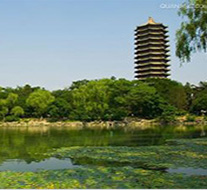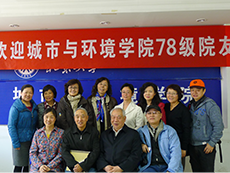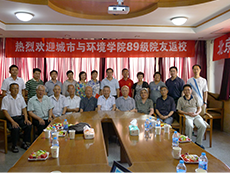
Liang Ma
Title:Associate Professor
Research Direction: Planning and Health; Transportation and Land Use
Department: Urban and Regional Planning
Tel: 62761104
Email:liang.ma@pku.edu.cn
Education and experience
Ph.D. Portland State University, Urban Studies, 2014.
Fields: Built Environment, Travel Behavior, and Health.
M.S. Peking University, Urban and Regional Planning, 2007.
Emphases: Urban Economics; GIS.
B.E. China University of Geosciences, Land Use Management, 2004.
Emphases: Land Resource Management.
Publications
§ Refereed Journal Articles
Ma, L., & Ye, R. (2022). Utilitarian Bicycling and Mental Wellbeing: Role of the Built Environment. Journal of the American Planning Association, 88(2), 262-276.
Ma, L., Ye, R., & Wang, H. (2021). Exploring the causal effects of bicycling for transportation on mental health. Transportation Research Part D: Transport and Environment, 93, 102773.
Ma, L., Ettema, D., & Ye, R. (2021). Determinants of bicycling for transportation in disadvantaged neighbourhoods: Evidence from Xi’an, China. Transportation Research Part A: Policy and Practice, 145, 103-117.
De Gruyter, C., Ma, L., Saghapour, T., & Dodson, J. (2020). How does the built environment affect transit use by train, tram and bus? Journal of Transport and Land Use, 13(1), 625-650.
Ye, R., De Vos, J., & Ma, L. (2020). Analyzing the association of dissonance between actual and ideal commute time and commute satisfaction. Transportation Research Part A, 132, 47-60.
Liu, C., Cao, M., Yang, T., Ma, L., Wu, M., Cheng, L., & Ye, R. (2020). Inequalities in the commuting burden: Institutional constraints and job-housing relationships in Tianjin, China. Research in Transportation Business & Management,100545.
Ma, L., & Ye, R. (2019). Does daily commuting behavior matter to employee productivity? Journal of Transport Geography, 76, 130-141.
Ma, L., & Cao, J. (2019). How perceptions mediate the effects of the built environment on travel behavior? Transportation, 46(1), 175-197.
Ma, L., Kent, J., & Mulley, C. (2018). Transport disadvantage, social exclusion, and subjective wellbeing: The role of the neighborhood environment—evidence from Sydney, Australia. Journal of Transport and Land Use, 11(1), 31-47.
Mulley, C., Tsai, C., & Ma, L. (2018). Does residential property price benefit from light rail in Sydney? Research in Transportation Economics, 67, 3-10.
Mulley, C., & Ma, L. (2018). How the longer term success of a social marketing program is influenced by socio-demographics and the built environment. Transportation, 45(2), 291-309.
Lucas, K., Phillips, I., Mulley, C., & Ma, L. (2018). Is transport poverty socially or environmentally driven? Comparing the travel behaviours of two low-income populations living in central and peripheral locations in the same city. Transportation Research Part A: Policy and Practice, 116, 622-634.
Ma, L., Mulley, C., & Liu, W. (2017). Social marketing and the built environment: What matters for travel behaviour change? Transportation, 44(5), 1147-1167.
Kent, J. L., Ma, L. (corresponding author), & Mulley, C. (2017). The objective and perceived built environment: What matters for happiness? Cities & Health, 1(1), 59-71.
Mulley, C., Ma, L., Clifton, G., & Tanner, M. (2017). Are network planning guidelines based on equal access equitable? Transportation Research Record: Journal of the Transportation Research Board, (2651), 1-11.
Mulley, C., Sampaio, B., & Ma, L. (2017). South Eastern Busway Network in Brisbane, Australia: Value of the Network Effect. Transportation Research Record: Journal of the Transportation Research Board, (2647), 41-49.
Mulley, C., Clifton, G., Balbontin, C. & Ma, L. (2017). Information for travelling: Awareness and usage of the various sources of information available to public transport users in NSW. Transportation Research Part A, 101, 111-132.
Olaru, D., Mulley, C., Smith, B. & Ma, L. (2017). Policy-led selection of the most appropriate empirical model to estimate. Journal of Transport Geography, 62, 213-228.
Dong, H., Ma, L., & Broach, J. (2016). Promoting Sustainable Travel Modes for Commute Tours: A Comparison of the Effects of Home and Work Locations and Employer-Provided Incentives. International Journal of Sustainable Transportation, 10(6), 485-494.
Mulley, C., Ma, L., et al. (2016). Residential property value impacts of proximity to transport infrastructure: An investigation of bus rapid transit and heavy rail networks in Brisbane, Australia. Journal of Transport Geography, 54, 41-52.
Ma, L. & Dill, J. (2015). Associations between the Objective and Perceived Built Environment and Bicycling for Transportation. Journal of Transport & Health, 2(2), 248-255.
Ma, L. & Dill, J. (2015). Do People’s Perceptions of Neighborhood Bikeability Match Reality? Journal of Transport and Land Use, 10(1), 291-308.
Ma, L., Dill, J., & Mohr, C. (2014). The Objective versus the Perceived Environment: What Matters for Bicycling? Transportation, 41(6), 1135-1152.
Ma, L., Ye, R., & Titheridge, H. (2014). Capitalization Effects of Rail Transit and Bus Rapid Transit on Residential Property Values in a Booming Economy. Transportation Research Record: Journal of the Transportation Research Board, 2451(1), 139-148.
Dill, J., Mohr, C., & Ma, L. (2014). How Can Psychological Theory Help Cities Increase Walking and Bicycling? Journal of the American Planning Association, 80(1), 36-51.
Dill, J., McNeil, N., Broach, J., & Ma, L. (2014). Bicycle boulevards and changes in physical activity and active transportation: Findings from a natural experiment. Preventive medicine, 69, S74-S78.
§ Non-Refereed Reports
1. Jennifer Dill, Marc Schlossberg, Liang Ma, Cody Meyer, “Measuring the Performance of Transit Relative to Livability,” FHWA-OR-RD-13-07. March 2013.
2. Ma, L., Dill, J., Schlossberg, M. & Meyer, C. (2014, October). Walking to the station: The role of walkability on transit use. Invited talk at XV International Conference on Walking and Liveable Communities (Walk 21), Sydney, Australia.
3. Ma, L. (2017). How can neighbourhood environments reduce transport disadvantage and social exclusion? Planning News, 43(6), 19.





